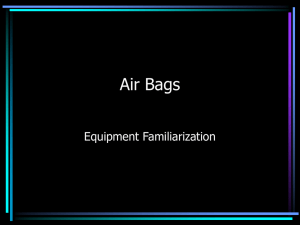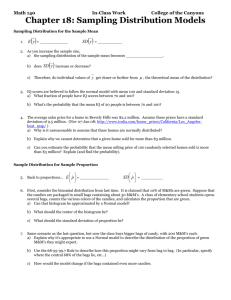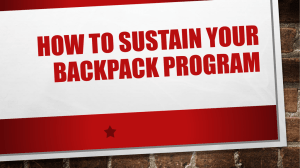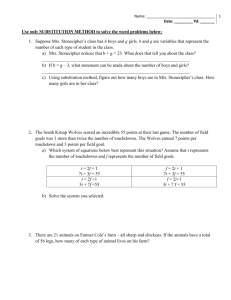Shipping Salty Snacks with Buffer Bags Problem Air
advertisement
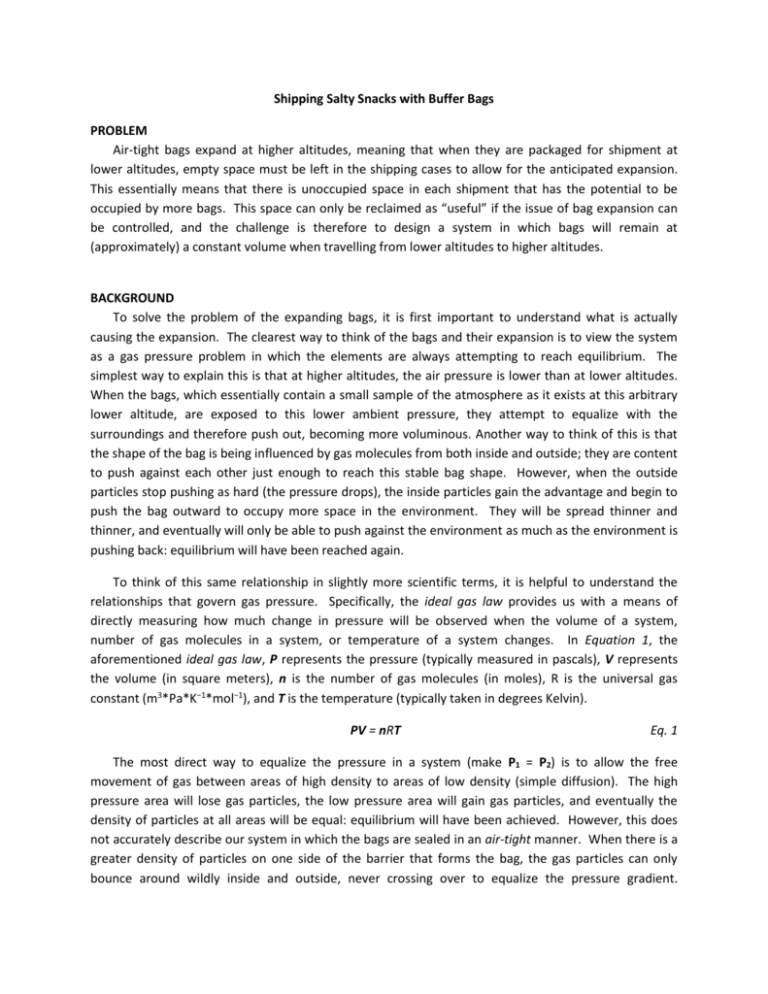
Shipping Salty Snacks with Buffer Bags PROBLEM Air-tight bags expand at higher altitudes, meaning that when they are packaged for shipment at lower altitudes, empty space must be left in the shipping cases to allow for the anticipated expansion. This essentially means that there is unoccupied space in each shipment that has the potential to be occupied by more bags. This space can only be reclaimed as “useful” if the issue of bag expansion can be controlled, and the challenge is therefore to design a system in which bags will remain at (approximately) a constant volume when travelling from lower altitudes to higher altitudes. BACKGROUND To solve the problem of the expanding bags, it is first important to understand what is actually causing the expansion. The clearest way to think of the bags and their expansion is to view the system as a gas pressure problem in which the elements are always attempting to reach equilibrium. The simplest way to explain this is that at higher altitudes, the air pressure is lower than at lower altitudes. When the bags, which essentially contain a small sample of the atmosphere as it exists at this arbitrary lower altitude, are exposed to this lower ambient pressure, they attempt to equalize with the surroundings and therefore push out, becoming more voluminous. Another way to think of this is that the shape of the bag is being influenced by gas molecules from both inside and outside; they are content to push against each other just enough to reach this stable bag shape. However, when the outside particles stop pushing as hard (the pressure drops), the inside particles gain the advantage and begin to push the bag outward to occupy more space in the environment. They will be spread thinner and thinner, and eventually will only be able to push against the environment as much as the environment is pushing back: equilibrium will have been reached again. To think of this same relationship in slightly more scientific terms, it is helpful to understand the relationships that govern gas pressure. Specifically, the ideal gas law provides us with a means of directly measuring how much change in pressure will be observed when the volume of a system, number of gas molecules in a system, or temperature of a system changes. In Equation 1, the aforementioned ideal gas law, P represents the pressure (typically measured in pascals), V represents the volume (in square meters), n is the number of gas molecules (in moles), R is the universal gas constant (m3*Pa*K−1*mol−1), and T is the temperature (typically taken in degrees Kelvin). PV = nRT Eq. 1 The most direct way to equalize the pressure in a system (make P1 = P2) is to allow the free movement of gas between areas of high density to areas of low density (simple diffusion). The high pressure area will lose gas particles, the low pressure area will gain gas particles, and eventually the density of particles at all areas will be equal: equilibrium will have been achieved. However, this does not accurately describe our system in which the bags are sealed in an air-tight manner. When there is a greater density of particles on one side of the barrier that forms the bag, the gas particles can only bounce around wildly inside and outside, never crossing over to equalize the pressure gradient. However, equilibrium hasn’t given up yet: there are still plenty of other variables that can be adjusted. To simplify the ideal gas law to better represent our system of bags, the terms n and R can be combined into one arbitrary constant, K. K will be different for every system, as there will be a different number of molecules of gas in each case, but since there will be no migration of these particles, it can be kept constant along with the gas constant R. This leads Equation 2 which still demonstrates the same relationships as Equation 1. PV = kT Eq. 2 It can now clearly be seen that there are only 3 more variables to be considered: pressure, volume, and temperature. By imagining three cases in which each of these terms is held constant, it is possible to better understand the physical relationship between each of them. For example, if the temperature of a system is held constant, pressure and volume can be seen to have an inversely proportional relationship: when one increases, the other must decrease. If pressure is held constant, volume and temperature are easily identified as varying in a directly proportional fashion: when one increases, the other must increase, vice versa. Finally, if a constant volume is being maintained, pressure and temperature must vary in a proportional manner. To sum this all up, an increase in pressure will cause a decrease in volume and/or an increase in temperature whereas a decrease in pressure will elicit the opposite effect. To most effectively maintain a constant volume, it is desirable establish control over the remaining variable that is simplest to manipulate. That is to say that the environmental pressure and temperature will be changing constantly, and if you can pick one to be able to control with a dimmer switch, it will be feasible to create the proper set of conditions to maintain the volume. For example, as you ascend the rocky mountains with your bags that you desire to maintain at a constant volume, the air pressure is going to drop (as is the temperature for that matter, for similar reasons as we have been reviewing). However, if you can measure the change in pressure that will be affecting the bags, you could find a way of cooling the bags so that their gaseous contents would lose some of their thermal energy and would not expand in the way that would normally be expected if the temperature were being held relatively constant. If you were to decrease the temperature too much, the bags might even begin to shrink, possibly crushing the contents. If you could directly control the ambient pressure immediately surrounding the bags (i.e. in the shipping container), then you could monitor the temperature, and adjust the ambient pressure so that the volume was not altered. On this same train of thought, because the decrease in pressure is ultimately the reason why the bags expand, if you could simply maintain an environment of known or controllable pressure, you could easily maintain a constant volume of the contained bags. This would essentially be a pressure vessel in which the internal conditions would not change, at least not dramatically, regardless of the external environment. To pressurize an entire shipping container would be extremely cost-inefficient when compared to the increase in shipping efficiency due to the great degree of specialization and adaptation that would be required. However, the shipping container is only one potential barrier between the bags and their immediate environment. This is where the soon-to-be proposed solution stems from. DEFINITIONS In describing the proposed solution there are a few terms that need to be kept straight. Pressures: Atmospheric—outside, environmental air pressure Ambient – air pressure immediately surrounding object of discussion (relative) Internal—air/gas pressure on inside of membrane/container External—sir/gas pressure on outside of membrane/container Air/Gas—used interchangeably to indicate a gaseous mixture Container—when a reference is made to the pressure of a container, it is referring to the pressure of the gas molecules located only directly within that container, not within enclosed containers. Containers: (Shipping) Container—largest unit of shipment (i.e. box car or semi-trailer) (Shipping) Case—box in which the individual product units are contained Buffer (Bag)—membranous, gas impermeable barrier completely enclosing product; new design for solution Product (Bag)—product unit that is being shipped and must be maintained at constant volume SOLUTION Concept The proposed solution is to use the expansion of a newly designed air-tight bag in low pressure environments to prevent the expansion of the current air-tight bags. This will be accomplished by creating a micro-environment in which the pressure in not affected by volume or gas exchange, and the temperature change is negligible. If the product bags are placed in this environment, and the same conditions can be maintained at elevation, no expansion will occur. This will mean that the packaging will be more efficient by a factor equal to the empty space previously necessary. The new air-tight bag will be known as the “buffer bag” for the rest of this discussion and is the essence of the solution. To explain a little more thoroughly, the idea is essentially to create a “one way” pressure vessel. As can be seen in the attached Figures 1, the shipped bags are currently expanding to fill the entire shipping case, because of an equalization of pressure. Figure 2 represents the change that would be effected by the addition of the buffer bag. The buffer bag, being affected by the lowered ambient pressure, will expand as the natural, expected reaction. However, when it makes contact with the rigid shipping case, it will no longer be able to expand. Therefore, the pressure will decrease only slightly within the buffer’s micro-environment, and the product bags inside will experience this same slight expansion. Assuming that the initial volume of the buffer bag is approximately equal to that of the shipping case, this increase in pressure/decrease in volume will be virtually unnoticeable, as will the increase in volume for the product bags. Figure 3 is simply an illustration of the fact that more bags will be able to be shipped per shipping container, or conversely the shipping containers could be made smaller (although this will not be an efficient use of material, unless there is *just* not enough room for one more bag. Figure 4 is a somewhat exaggerated illustration of what change will be experienced by the buffer bag. The “normal” condition is a little too flaccid and the “expanded” condition is not pushing out as fully as it likely would, but the general idea is conveyed. This concept will not prove useful at all when translating from high pressures to low pressures, as the means of regulating volume is simply to mechanically create a barrier (with the walls of the shipping case) that stops expansion/volume change at a pre-defined maximum. The important factor is that the volume remains constant and predictable, and since an expansion is all you have to worry about when traveling from high pressure to low pressure, this maximum volume control is sufficient. Without the specific numbers it is impossible to calculate an initial set of conditions (concerning the exact volume/pressure of the product/buffer bags), but they can easily be determined so as to maximize the shipping. Buffer Bag Construction The “one way pressure vessels” (buffers) will serve their function by being impermeable to gasses, thin and flexible to conform to the shape and size of the container while not taking up any “extra space”, and able to conduct heat. I envision them as clear plastic, most likely a polyethylene of some sort, but the aforementioned properties are the only real relevant criteria. I am not a materials scientist or engineer, so I am not certain what would be best to use to fit these criteria while also being simple to incorporate into the manufacturing/packaging process. Polyethylene is relatively cheap, and can be fused with heat welding, but I am sure there are other options that might be more suitable to this design. This all being said, the attached Figures 5-6 illustrate possible structures that I have brainstormed. The biggest trick is going to be getting the product into the buffer and then sealing the buffer while ensuring the correct initial pressure/volume. One thought is to leave a flap open in the buffer, into which the product can be placed. Figure 5 is an attempt at this design, but both sealing the edged of the top flap as well as packaging the product will be cumbersome, and neither of these are particularly appealing attributes of this design. Another more feasible design is to simply construct the bottom and sides of the buffer, place them inside the case, load the product into the bufferlined case, and then seal the top of the buffer shut. This general design is illustrated in Figure 6 where the sides (front, back, left, right) are all constructed of one piece and the top and bottom are fitted into this shape by folding the edges and corners around to fit inside (or outside if it is possible from a manufacturing standpoint). Only the sides and bottom will be assembled before loading the product bags into the buffer bag/case. Then the top will be sealed, completing the buffer bag. There will still need to be some means of ensuring the correct pressure and volume right before the final seal is made, but a machine could fairly simply be made to do this. If a seal were created around where the heat-welding (or other form of sealing, depending on the material) was happening, pressure could be maintained at the correct value to fill the buffer bag with the right amount of air. Depending on the conditions (i.e. product destination, pressure inside the product bags, etc.), the amount of air in the buffer bag could be adjusted. Assuming that the buffer was constructed of thin material and to the size/shape of the container, at atmospheric pressure the buffer should just touch the sides of the case. It will then be ready to ship. One general consideration that would impact bag design would be the intended lifecycle of the buffer bags. If shipments were leaving the same area they were being delivered to, the buffer bags could be reused for the same task, and a more robust, expensive design may be warranted. The bags could themselves contain some of the rigidity necessary to put a cap on the volume in the form of cross-layers of “non stretchable” material. This would take some of the stress off of the shipping case, and the material for that could be less bulky or structurally important. Otherwise they could simply be air-tight and strong enough not to be punctured by a stray piece of cardboard for one trip, and be recycled at the destination (assuming a recyclable material, of course, which would be ideal and quite feasible). This discussion does bring to light another important factor: the actual shipping case will need to be examined to see if the buffer bag design will mesh. If the cases are flimsy and thin material, the buffer bag will simply continue its expansion outward, causing the cases to bulge, deform, and expand. (The product bags will also expand, but they are basically irrelevant at this point, because they are contained within the volume of the larger buffer bag.) Even if a little bulging is experienced, the design is not useless, because the product bags are assumedly being transported over the Rocky Mountains. If they were being opened at the top of the mountain (or at high elevation in general), opening the cases would likely be unpleasant as the buffer bag would rapidly expand upon opening the shipping case, and the product bags would expand upon opening the buffer bag. However, this is not a solution for that problem and I do not deem this limitation to be relevant in these circumstances. Conclusion This solution is really quite simple at its core. An air-tight container will attempt to expand in volume when subjected to an ambient pressure that is lower than its internal pressure. And so, the simplest way to prevent this expansion is to control the ambient pressure. To do this, a microenvironment must be created in which the pressure remains relatively constant, regardless of the environmental air pressure. This micro-environment will be created using “buffer bags” that are sealed around the bags of product which need to maintain a constant volume. The volume of the buffer bag at the time of packaging will be very close to that of the internal volume of the shipping case. This means that the buffer bag will very quickly fill all of its available space once the external pressure drops and the amount of possible expansion (and therefore decrease in pressure) will be minimized. The buffer bag will be the immediate environment of the product bags, and therefore the pressure difference between the product bags and the new, slightly lower pressure of the buffer bag will cause a small increase in volume. However, this will be a much smaller volume change than without the buffer bag, and as a result more bags can be packed per buffer-bag-equipped shipping case. POSSIBLE ISSUES The temperature variable is not being actively controlled here, which appears to go against the claim that was made earlier about how the ideal gas law is the be-all-end-all for designing a solution. If pressure is being controlled but temperature is allowed to run rampant, then what good is being done? This is an interesting scenario in which other contending forces must be considered. Just as pressure is attempting to equilibrate, so is thermal energy. Heat is constantly flowing from areas of “high density” (hot things) to areas of “low density” (cold things). The kinetics are not necessary to understand for the general theme of this concept, but it is important to realize that certain materials are more thermally conductive, just as some materials are more electrically conductive. If the materials that are used in the system have high thermal conductivity (that is, they allow heat to flow quite freely), then it is possible for heat exchange to occur across the membrane where gas exchange is prohibited. Therefore, any marked increase or decrease in heat energy inside/outside the product bags, buffer bags, shipping container, etc. will essentially allow the equilibration of the heat. A call for a decrease in pressure might elicit a cooling response, but this will be largely offset by the ambient temperature attempting to establish equilibrium with all elements in the system. INTERESTING NOTES Using the highest point in the US interstate system (12,182 ft. or 3713 m. on Rt. 34 in Colorado between Estes Park and Grand Lake) as the assumed maximum for altitude, and Equation 3 which relates air pressure (P, in pascals) to elevation above sea level (h, in meters), the lowest pressure that could be experienced by the shipment would be 100,726 Pa. P = 101325*(1 - 2.25577x10-5*h)5.25588 Eq. 3 Assuming that the lowest altitude (and therein pressure) would be sea level at 101,325 Pa, the percent increase in volume, assuming constant temperature, would only be .60%. This essentially means that for every 167 bags that held at constant volume would allow for one extra bag to be shipped. However, experimentally this value may be larger due to other factors such as temperature or weather patterns that cause a deviation from the pressure calculated from Equation 3. Also, a solution may be deemed worthwhile for such a small increase in efficiency. ATTACHMENTS


